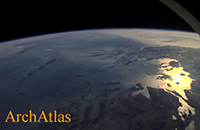Global View: A framework for expansion

How to organise a global view of archaeology? The aim of this website is to provide maps and imagery which complement our understanding of the ancient world, and suggest new approaches to it...
ArchAtlas was the inspired creation of Professor Andrew Sherratt. Its origins lay in thirty years of research and teaching in world archaeology. The web site started as a small pilot project in 2000, making use of new technologies, to provide an outlet for ideas which could not be expressed in other media. Much of the initial content, images and text were created by Andrew or under his direction, from the cited sources, and reflected his opinions about the topics under discussion. The “visual essays” listed below are those written by Andrew before his untimely death in 2006, or solicited by him from other authors.














